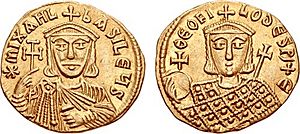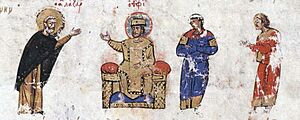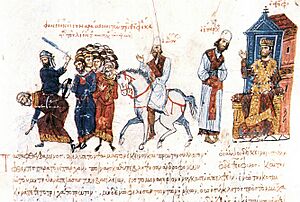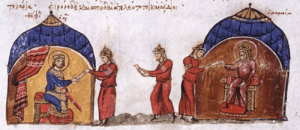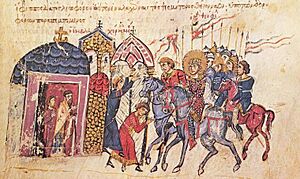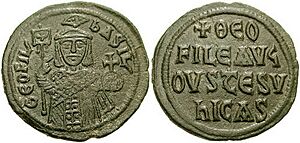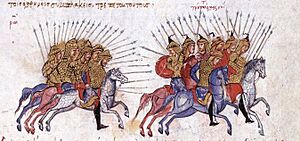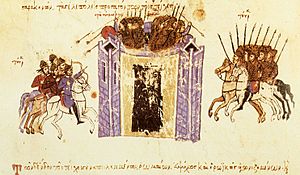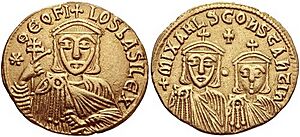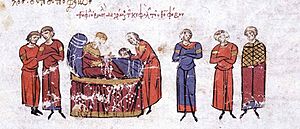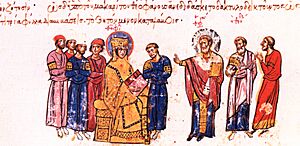Theophilos (emperor) facts for kids
Quick facts for kids Theophilos |
|
|---|---|
| Emperor of the Romans | |

Theophilus, in the Chronicle of John Skylitzes
|
|
| Byzantine emperor | |
| Reign | 2 October 829 – 20 January 842 |
| Coronation | 12 May 821 |
| Predecessor | Michael II |
| Successor | Michael III and Theodora |
| Co-emperor | Constantine (830s) |
| Born | 812 |
| Died | 20 January 842 (aged 30) |
| Consort | Theodora |
| Issue | Constantine Thekla Anna Anastasia Pulcheria Maria Michael III |
| Dynasty | Amorian dynasty |
| Father | Michael II |
| Mother | Thekla |
Theophilos (Greek: Θεόφιλος, romanized: Theóphilos; Latin: Theophilus, around 812 – 20 January 842) was the Byzantine Emperor from 829 until he passed away in 842. He was the second emperor from the Amorian dynasty. Theophilos was also the last emperor to support iconoclasm, which was a belief against using religious images. He personally led his armies in a long war against the Arabs, starting in 831.
Contents
The Emperor's Life
Early Years and Education
Theophilos was the son of Emperor Michael II and his wife Thekla. His father, Michael II, was known as a Greek-Jewish emperor. Theophilos was also the godson of Emperor Leo V the Armenian.
In 821, Michael II made Theophilos a co-emperor. This meant they ruled together. Theophilos received a very good education from a teacher named John Hylilas. He really loved music and art. On October 2, 829, Theophilos became the sole emperor after his father passed away.
Ruling Style and Beliefs
Theophilos continued the policy of iconoclasm. This meant he did not allow the use or worship of religious images, called icons. In 832, he even made a law forbidding people from honoring icons.
He also believed strongly in justice. Right after he became emperor, he made sure to punish those who had plotted against the previous emperor, Leo V.
Wars Against the Arabs
When Theophilos became emperor, he had to fight wars against the Arabs on two different fronts. The Arabs invaded Sicily again and took Palermo in 831 after a long fight. They then created the Emirate of Sicily and slowly took over more of the island.
The Emperor himself led the defense when the Arabs invaded Anatolia in 830. However, the Byzantines were defeated and lost several forts. In 831, Theophilos fought back. He led a large army into Cilicia and captured the city of Tarsus. The Emperor returned to Constantinople feeling victorious. But later that year, he was defeated in Cappadocia.
Another defeat in 833 forced Theophilos to ask for peace. He offered a lot of gold and to return 7,000 prisoners. He got the peace treaty the next year, after the Arab leader Al-Ma'mun died.
During a break from the war with the Arabs, Theophilos helped rescue Byzantine prisoners. These prisoners had been settled north of the Danube river by Krum of Bulgaria. The rescue worked well around 836, and peace was quickly made between Bulgaria and the Byzantine Empire.
However, peace in the East did not last. In 834, Theophilos gave a safe place to many refugees from the East, including a Persian man named Nasr. He even baptized one of them, Theophobos, who married the Emperor's aunt and became one of his generals. As relations with the Arabs got worse, Theophilos got ready for a new war.
In 837, Theophilos led a huge army of 70,000 men towards Mesopotamia. They captured Melitene and Arsamosata. The Emperor also took and destroyed Sozopetra. Some say this was the birthplace of the Arab leader, Caliph al-Mu'tasim. Theophilos returned to Constantinople in triumph.
Wanting revenge, Al-Mu'tasim gathered a massive army. He launched a two-part invasion of Anatolia in 838. Theophilos decided to attack one part of the caliph's army before they could join up. On July 21, 838, at the Battle of Anzen, Theophilos personally led a Byzantine army against the Arab troops. The Byzantines were defeated, and the survivors retreated.
Al-Mu'tasim then took Ancyra, and his general al-Afshin joined him there. The full Arab army then moved towards Amorium. This city was very important to the Byzantine ruling family. The city fought bravely for 55 days. But a Muslim prisoner escaped and told the caliph about a weak part of the wall. Al-Mu'tasim attacked that spot, and the wall was broken. The city of Amorium fell to al-Mu'tasim on August 12 or 15, 838.
In 838, Theophilos wanted to impress the Caliph of Baghdad. So, he had a man named John the Grammarian give a lot of money to the people of Baghdad. Around 839 or 840, Theophilos also started talking with the Emirate of Córdoba in Spain. His ambassador, Krateros, made a friendship agreement with Theophilos against the Abbasids.
Around 841, the Republic of Venice sent 60 ships to help the Byzantines fight the Arabs near Crotone, but they were not successful. During this time, Al-Mu'tasim found out that some of his top generals were plotting against him. Many were arrested and some were executed. Caliph al-Mu'tasim became sick in October 841 and died on January 5, 842.
It is said that Theophilos, even though he fought the Arabs, built a palace in Bryas that looked like buildings in Baghdad.
Relations with Bulgaria and Serbia
In 836, a 20-year peace treaty between the Byzantine Empire and Bulgaria ended. Theophilos attacked the Bulgarian border. The Bulgarians fought back, and their leader Isbul reached Adrianople. Around this time, the Bulgarians took over Philippopolis and the areas around it. Khan Malamir of Bulgaria died in 836.
Peace between the Serbs, who were allies of the Byzantines, and the Bulgars lasted until 839. Vlastimir of Serbia brought several Serb tribes together. Theophilos gave the Serbs independence, and Vlastimir agreed to be under the Emperor's rule.
The Bulgarians taking over western Macedonia changed things. The Bulgarian leader, Presian I, may have seen the Serbs uniting as a threat. He decided to try and conquer them. Another reason for the war might have been that the Byzantines wanted to distract the Bulgarians. They might have encouraged the Serbs to start the war so the Byzantines could deal with a Slavic uprising.
Khan Presian I invaded Serbian land in 839. This led to a three-year war. Vlastimir was victorious, and Presian was badly defeated. He did not gain any land and lost many of his soldiers. The Serbs had an advantage fighting in the hills. The war ended when Theophilos died, which meant Vlastimir was no longer tied to the Byzantine Empire.
Death and Legacy
Theophilos's health slowly got worse, and he died on January 20, 842. He was remembered as a fair judge. In a famous story called Timarion, Theophilos is shown as one of the judges in the Netherworld.
Theophilos made the Walls of Constantinople stronger. He also built a fort called Sarkel on the Don river in Khazar lands. He created new areas of rule called themes in Cherson, Paphlagonia, and Chaldia. He also built a hospital that lasted until the end of the Byzantine Empire.
Family Life
Theophilos and his wife Theodora had seven children: two sons and five daughters.
- Constantine (around 830 – around 836). He was a co-emperor from about 833 to 836. He sadly drowned in an accident at home.
- Thekla (around 831 – after 867). She was given the title Augusta. Her image appeared on coins when her mother was ruling. Later, her brother Michael sent her to live in a monastery.
- Anna (born around 832). She was sent to live in the monastery of Gastria when she died.
- Anastasia (born around 833). She was also sent to live in the monastery of Gastria when she died.
- Pulcheria (born around 836). She was sent to live in the monastery of Gastria when she died.
- Maria (born around 838). She was promised to marry a man named Alexios Mosele. She was sent to the monastery of Gastria before her sisters and died before they were sent there.
- Michael III (840 – 867). He became emperor after his father.
See also


